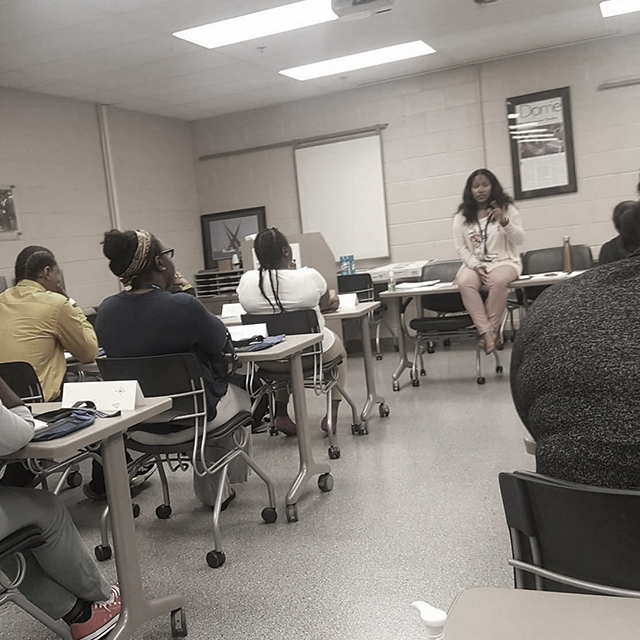Juliet Gabriel always wanted to go to nursing school, but she couldn’t picture herself in the hospital environment. That is, until she went through the Johns Hopkins Anesthesia Technologist Program and got real-world experience in an operating room.
“When I first set foot in the OR, I was amazed. I loved it. It was just filled with intelligent people — nurses, anesthesia techs, surgical techs, the attending physicians, the residents,” she says. “I realized that this is a surrounding that I wanted to be in. Everybody in that OR represented different growth prospects, and I was finding where I fit in.”
For Gabriel, becoming a certified anesthesia technologist was a springboard into nursing school. After she graduated from the program in 2020, she attended nursing school. In September, she started working as an intensive care nurse at The Johns Hopkins Hospital.
The yearlong program, a collaboration with the Community College of Baltimore County (CCBC), prepares graduates to become nationally certified anesthesia technologists. The designation replaces the anesthesia technician certification, which is no longer offered by the American Society of Anesthesia Technologists and Technicians (ASATT).
The program, founded in 2017, was created to meet the rising demand for anesthesia support staff as their services are needed more and more outside of the operating room for procedures ranging from interventional radiology to pediatric MRIs. It was designed by Kim Allen, program director and certified anesthesia technologist; Shannon Yorkman, a nurse anesthetist who teaches most of the program’s lab-based courses; and Michael Phelps, an anesthesiologist who serves as the program’s medical director.
The program, which was the first of its kind in the region, positions graduates to take the ASATT exam.
This year, the program became accredited by the Commission on Accreditation of Allied Health Education Programs. Anesthesia technologist programs launch as “approved schools” and are then accredited after a site visit and good exam passage rates. Only eight other schools in the country are accredited.
Starting with its first class, the program has graduated 32 students, 20 of whom got jobs at Johns Hopkins as anesthesia technologists. One student who hopes to go to medical school received a full scholarship to the University of Maryland Baltimore County for her bachelor’s degree after completing the program. Another student has taken advantage of the anesthesia program’s relationship with Towson University — credits from the program transfer for students looking to get a bachelor of technical and professional studies degree in allied health.
The most common career step for the anesthesia technology graduates is nursing school. Like Gabriel, at least six students are either in or have completed nursing school; another graduate works as an intensive care unit (ICU) nurse at Johns Hopkins as well.
Gabriel was working in the Johns Hopkins Core Lab as a technician and as a phlebotomist when she started the program. Many participants have been Johns Hopkins employees, including anesthesia technicians looking to get certified as technologists.
“The idea that we can take our own people who are driven and educate them to handle complex clinical scenarios, and give them a proven pathway to go even further, that’s really critical right now,” says Phelps, who is also an assistant professor of anesthesiology and critical care medicine at the Johns Hopkins University School of Medicine.
Gabriel used a Johns Hopkins program called Project REACH, which allows employees to work part-time hours but retain full-time pay to further their education. The program aims to address chronic and critical staff shortages at Johns Hopkins. With staffing shortages in hospitals all over the country, Phelps says the program has worked as a feeder system for Johns Hopkins.
“That’s allowed us to avoid catastrophic staffing issues in our tech staff because we’ve been able to produce new people each year,” he says. “That’s a fairly unique concept because most schools in the country are not linked to a hospital.”
Similar to other allied health fields, admission into the Anesthesia Technologist Program requires prerequisites such as chemistry, anatomy and physiology, and medical terminology. Upon completion, students earn an Associate of Applied Science degree in anesthesia technology from CCBC and a certificate of completion from the Johns Hopkins Department of Anesthesia and Critical Care Medicine.
In the program, students learn about anatomy, physiology, pathophysiology, pharmacology and principles of anesthesia technology. All graduates must complete advanced cardiac life support training as well. Phelps teaches four courses, including fundamentals of anesthesia, which includes understanding equipment and information about the field’s background and history, and pharmacology, which teaches about different anesthesia medications and their side effects as well as how to interpret lab results to anticipate patient needs.
Gabriel believes the program helped her get into all three nursing schools she applied to, and gave her a head start as an incoming ICU nurse. Because she worked as an anesthesia technologist for more than two years, she says she knows how to anticipate what physicians might need in various scenarios and how to work a variety of machines in the OR and ICU.
“Becoming an anesthesia technologist really boosted me up to then becoming a nurse. You have no idea how helpful that program was for me in nursing school,” she says. “I’m stepping into the nursing field as an anesthesia critical care technologist and a new grad nurse. I know what trauma is like — I will not panic if I’m getting a patient who is profusely bleeding, because I know what to do from my experience and training.”


